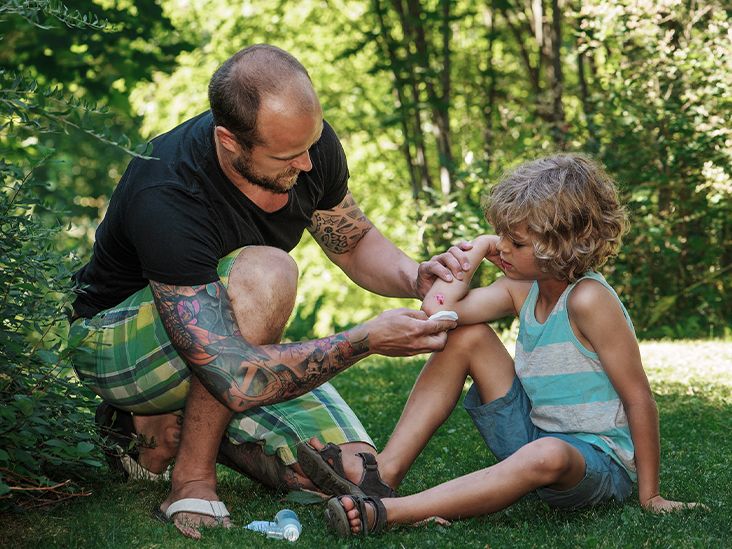For moderately severe open wounds, the safest and most effective over-the-counter (OTC) antiseptics include iodine, biguanides, and peroxides.
Antiseptics are chemical solutions applied topically to the skin or wounds to reduce the growth of harmful bacteria, viruses, or fungi.
Common OTC antiseptic types include:
- alcohols, such as isopropyl alcohol
- biguanides, such as chlorhexidine
- iodine
- peroxides
- halogenated phenols
You can typically take care of mild wounds with antibacterial soap and water, while more severe wounds may require medical attention. Here’s what to know about antiseptic use and its safety.
The Food and Drug Administration (FDA) considers some antiseptics to be safe to use on open wounds, while it considers ingredients in other OTC options to be potentially unsafe.
The FDA has listed 24 potentially harmful antiseptic ingredients to know about. However, only one is still an active ingredient marketed as a healthcare antiseptic today. At this time, the FDA considers triclosan to be potentially unsafe to use.
Although scientists haven’t explicitly proven these ingredients to cause harm, there’s limited evidence to back their use, and their long-term effects remain unknown.
With repeated use, even antiseptics considered safe, such as isopropyl alcohol, may cause cytotoxicity in the wound, meaning they can erode healthy cells and actually slow healing, 2022 research shows. Due to their potency, experts only recommend antiseptics for use when necessary or when there’s a legitimate risk of infection.
Keep in mind that milder cuts and scrapes won’t require any antiseptic to heal — antibacterial soap will be sufficient to disinfect the area.
If your cut is larger or more serious, it’s much safer to seek medical care — more on that below.
You shouldn’t use antiseptics for deeper or more serious wounds, including:
- burns or deep wounds, more than a quarter-inch deep
- large wounds or burns (i.e., those that may need to be stitched shut)
- wounds with excessive bleeding or that won’t stop bleeding after about 5 minutes of pressure
- any situation where a foreign object is embedded in the skin, especially rust
- any wound with signs of a serious infection (e.g., redness, pain, or pus)
- animal bites or scratches
- eye wounds
If your wound doesn’t seem to be healing with regular antiseptic treatment and care, it’s advisable to visit a doctor as soon as possible.
All types of antiseptics serve to disinfect the skin. However, there are a few that are both FDA-approved and specifically formulated to treat open wounds, including:
- Biguanides: These include chlorhexidine (Corsodyl, Covonia, Dermol, etc.). You can purchase these over the counter, and you can use them to prevent open wounds from becoming infected. They’ve been used for over 30 years in clinical settings and are often used in medical-grade hand washes, for wound cleaning, or for surgical skin prep.
- They’re also specifically ideal for treating mouth infections, sore throats, and skin infections. They come in the form of lozenges, mouthwashes, dental gels, and skin creams and lotions.
- Peroxides: These are mild antiseptics, such as hydrogen peroxide, and can be used to prevent infection with minor scrapes, burns, and cuts. They may also sometimes be used as a mouth rinse to treat issues like cold sores. However, they’re insufficient for deeper wounds.
- Iodine combined with povidone (like Betadine): This has a reputation as one of the most effective antiseptics for reducing the risk of infection for over a century. It has powerful antimicrobial action and low toxicity, and it works well to disinfect most mild to moderate wounds.
Antiseptics like alcohol can be used in a pinch but can be too harsh and may actually delay healing long term.
To treat and heal an open wound as soon as possible, here’s what to do:
- Wash your hands with antibacterial soap or use clean, disposable gloves.
- Rinse the wound with clean water or a water/saline solution to flush away dirt and debris.
- Clean the wound with water and a gentle antibacterial soap. If necessary, use tweezers to remove any remaining debris.
- Disinfect the wound with antiseptic, if necessary. For milder wounds, soap and water may be sufficient to disinfect the site. If you apply antiseptic, use a clean cotton pad or wound gauze to gently clean the area surrounding the wound. You don’t need to apply the solution directly to the wound unless instructed by a doctor.
- Apply ointment to seal and protect the wound. An antibiotic cream, like Neosporin, may be used for extra antibacterial action, but Vaseline or another petroleum jelly-based product will also help protect the site.
- Bandage the wound to keep germs out, either with an adhesive bandage or a dressing and tape. Remember that deeper wounds may require stitches. If the wound is infected or appears to be (i.e., it’s swollen), avoid using a bandage so it can breathe.
- Repeat the process at least once a day, per the Centers for Disease Control and Prevention (CDC) recommendation. Each time, check for signs of infection, including redness, swelling, or irritation. To promote healing and prevent scarring, avoid picking at any scabs.
Effective and safe OTC antiseptic options to treat wounds at home include iodine, peroxide, and biguanides.
Mild wounds typically don’t require antiseptic use, and you can safely disinfect them with soap and water. More severe wounds, such as those deeper than a quarter-inch, require support from a medical professional.
If your wound appears infected or isn’t healing, visit a doctor, clinic, or other healthcare professional.

